Fate by Anita Luo and Calvin Lin
Proposal
I. Project Title: Fate
II. Team Members: Anita Luo and Calvin Lin
III. Concept |Storyline:
1). What is the piece (article, poem, story) for the narrative voice over? Or who are you going to interview?
The piece for the narrative voiceover could be a reflective monologue or letter written by one of the lovers, expressing their thoughts and feelings about the rekindled meeting and the memories that resurface. Alternatively, it could be a series of journal entries or inner thoughts narrated by the characters.
2). What’s the story about?
The story is about the complex emotions and nostalgia that resurface when two former lovers reunite after a breakup. It explores themes of love, regret, and the passage of time.
3). Which part of the story are you going to focus on?
The focus of the story could be on the moments of reconnection between the two lovers, particularly when their memories flashback. It could delve into the tension between their shared history and the realization that they have both changed and moved on.
4). What kind of style/aesthetics are you going to pursue?
The style/aesthetics could be characterized by a dreamy, nostalgic atmosphere with soft lighting, muted colors, and evocative music. The use of flashbacks can be visually distinct, perhaps with a slightly faded or sepia-toned look to distinguish them from the present-day scenes. The narrative voiceover can be introspective and poetic, reflecting the characters’ inner turmoil and bittersweet emotions.
IV. Execution Plan:
1). What equipment are you going to use when shooting the movie? (cell phone, DSLR camera, sound recorder, stabilizer..)
DSLR camera, stabilizer, cell phone, sound recorder, and lighting.
2). Which locations will it be shot at? When is it? Day time/night/unknown? Why?
The locations could include places that hold significance to the characters, such as their former favorite spots or places from their past relationship. Depending on the narrative, scenes can be shot during various times of the day or night to convey different emotions and atmospheres. For example, daytime scenes may symbolize hope and a fresh start, while nighttime scenes may evoke nostalgia and reflection. Seasons can also come into play—Autumn is cold whereas Summer or Spring is lively. The choice of locations and timing should align with the emotional journey of the characters and the mood of the story.
3). What are some challenges you might encounter and how will you prepare?
Potential challenges and preparations:
-
- Weather: Unpredictable weather conditions can affect outdoor shoots. Preparations may include having backup shooting days or using weatherproof equipment.
- Emotional scenes: Actors may need support and rehearsal time to convey the depth of emotions realistically.
- Logistics: Coordination for props, costumes, and actors’ schedules must be well-planned to avoid delays.
- Budget constraints: Ensuring that the budget covers all necessary expenses is crucial.
4). How will you collaborate? How will you divide work? (Gantt Chart below*)
- Schedule: We will create a timeline with key steps and deadlines, and allocate tasks based on our strengths and availability. We will use project management tools or collaborative platforms to enable communication and task tracking such as Google Docs or WeChat. We will also utilize the Gantt Chart offered in the template.
- Discussions: We will have open discussions and brainstorming sessions to generate creative ideas for the project. Consider everyone’s input and find consensus on the direction to take.
- Rehearsals and practice sessions: We will schedule rehearsals to refine performances, test camera angles, and ensure smooth coordination among the two of us. Constructive feedback will also be provided to help improve the overall quality of the project.
- Film and edit: We will follow our storyboard and capture the scenes as planned. Afterward, we will collaborate on the editing process, combining footage, adding effects, and refining the final product in sections/scenes so that we can delegate work.
- Review and feedback: We will discuss places of improvement and make necessary revisions to enhance the overall quality of our project.
V. Storyboard Draft
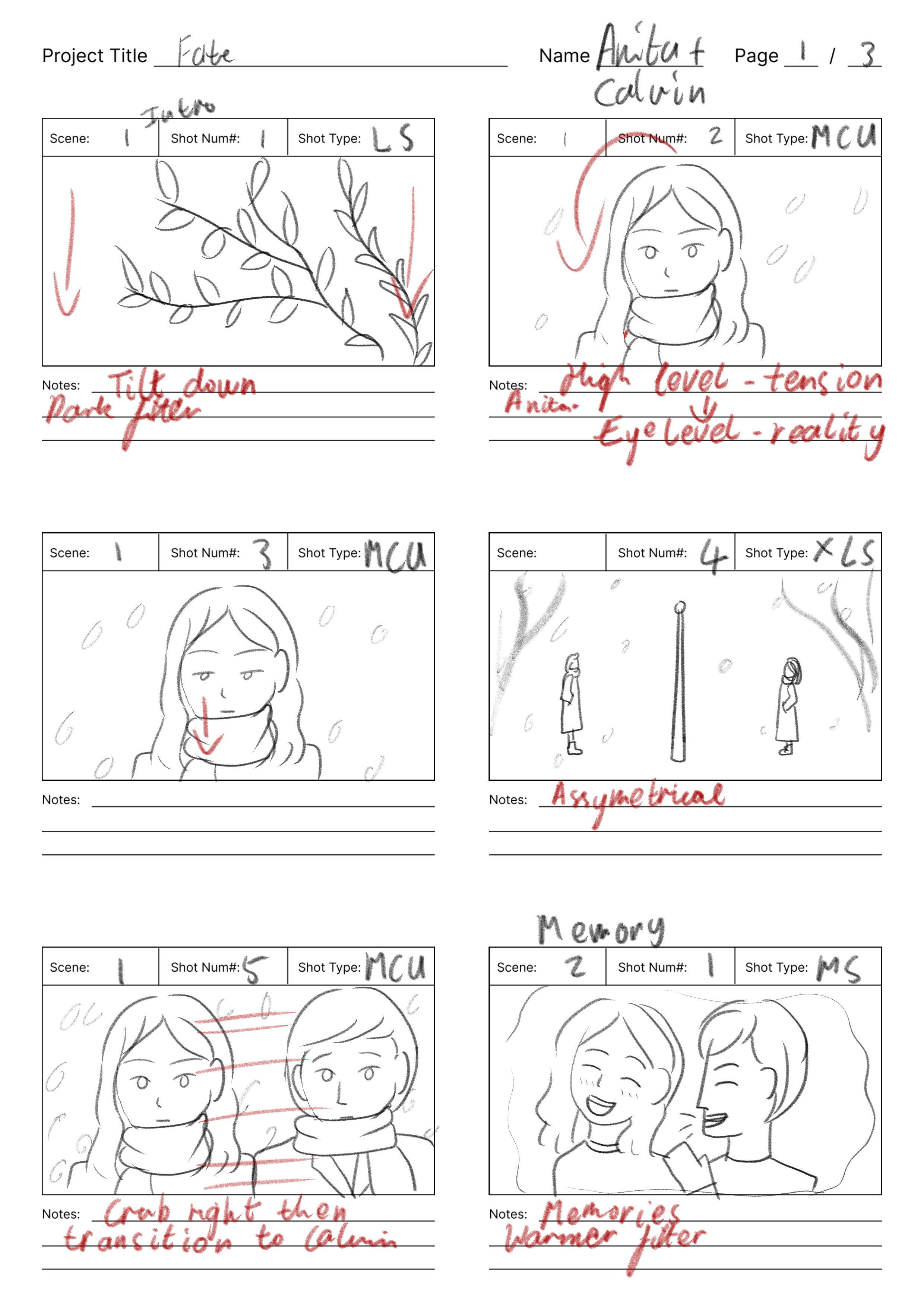
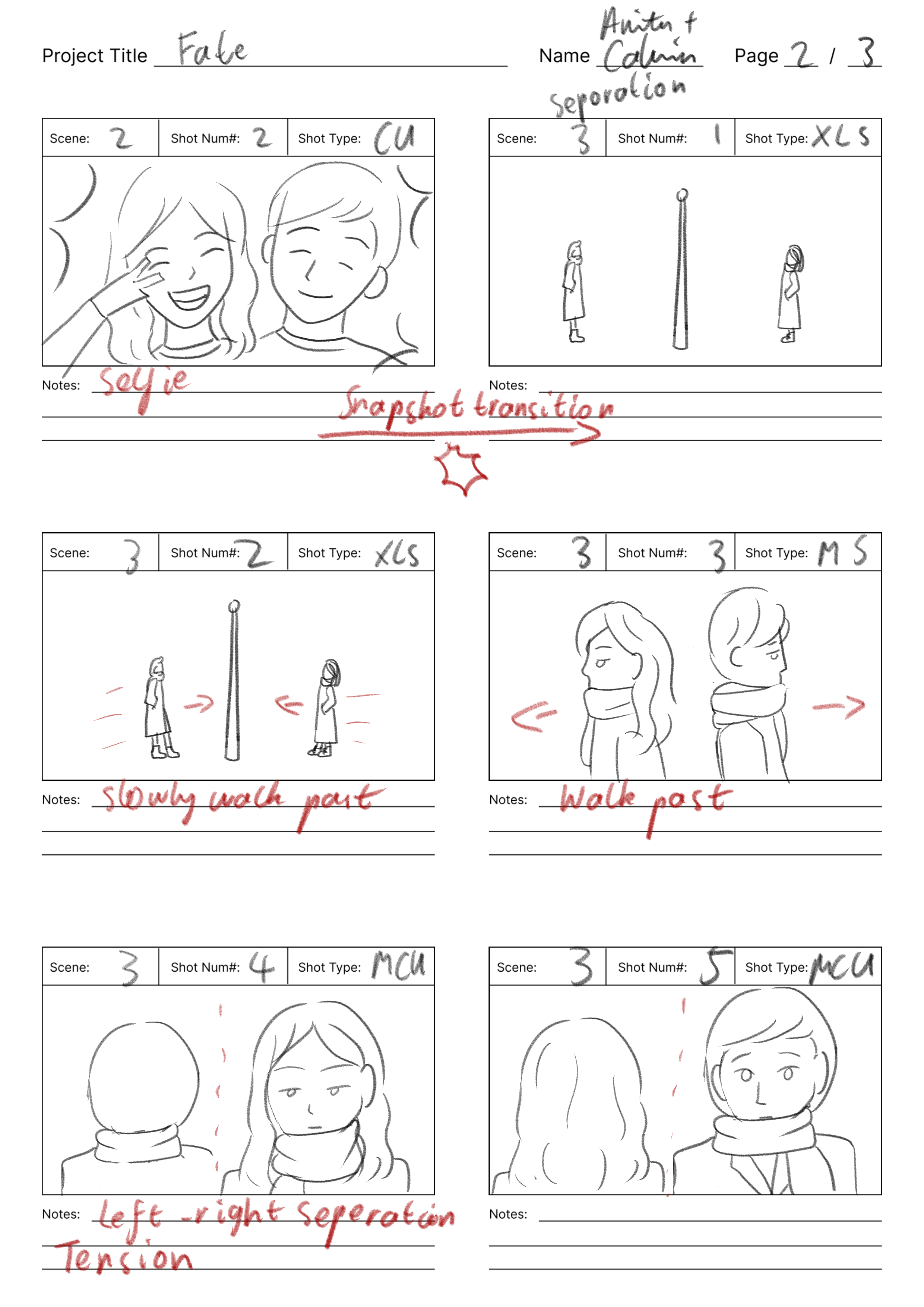
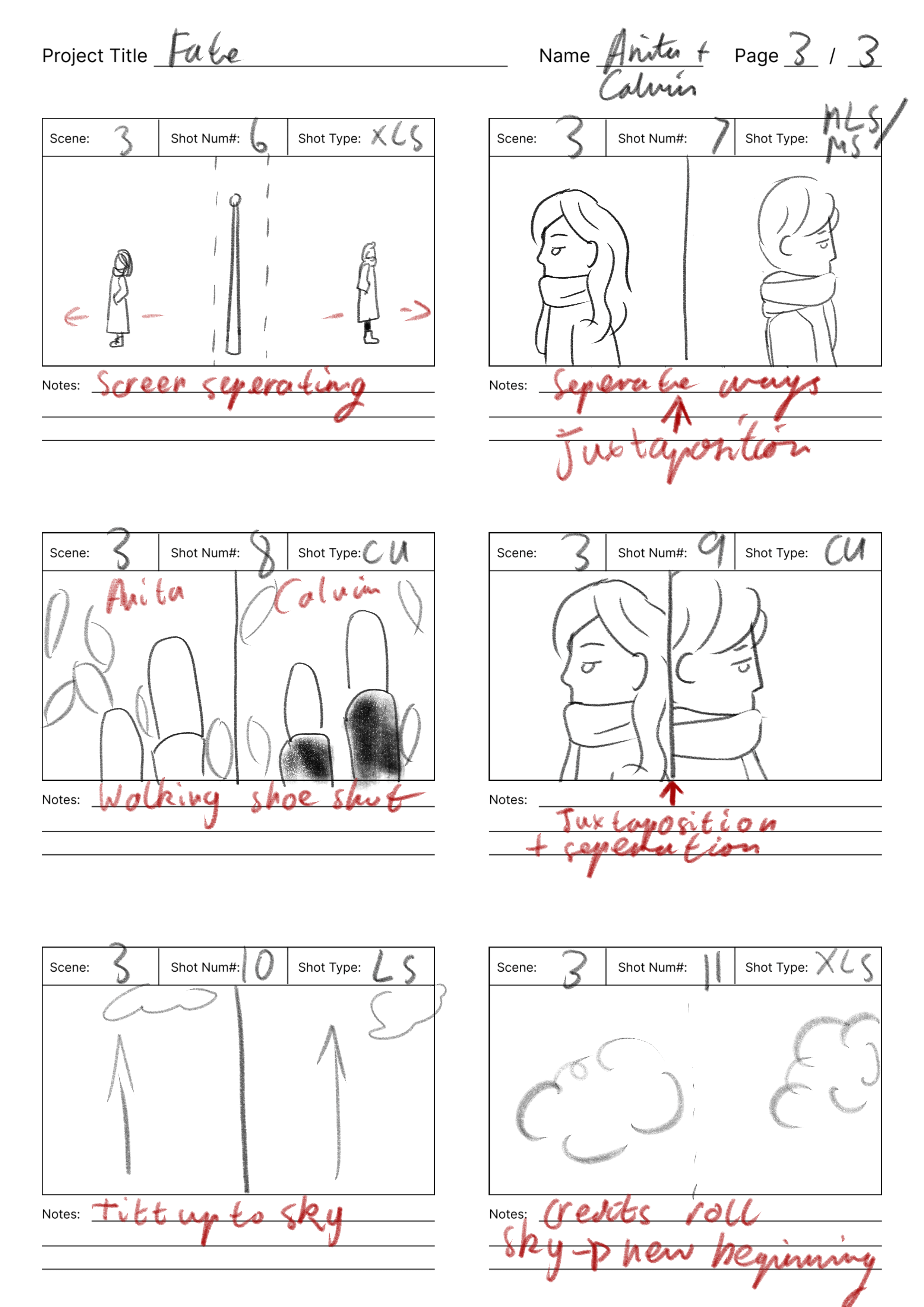
VI. Schedule
| Task | Owner | Start Date | Due Date | Duration | Task Complete Percentage |
| Proposal write-up | Calvin | 11/21 | 11/22 | 1 day | Done |
| Proposal Storyboard | Anita | 11/21 | 11/22 | 1 day | Done |
| Filming 2-3 scenes | Anita & Calvin | 11/29 | 11/30 | 1 day | Done |
| Filming the rest | Anita & Calvin | 12/02 | 12/02 | 1 day | Done |
| Editing the structure and sound | Calvin | 12/02 | 12/05 | 2 days | Done |
| Editing filters, color correction, and subtitle | Anita | 12/05 | 12/06 | 1 day | Done |
Brainstorming
The ideation process for “Fate” involved brainstorming sessions where we generated ideas for the storyline, characters, and visual aesthetics. We drew inspiration from classic romance films and literature while adding our unique twist to the narrative. Our goal was to craft a compelling story that would engage viewers emotionally.
Inspiration & Conceptual Integration
Inspiration
The inspiration for this project came from our shared love for romantic dramas and the idea of exploring the themes of love, regret, and the passage of time. We wanted to create a story that would evoke strong emotions and resonate with audiences who have experienced the complexities of past relationships.
Concept
Our project, “Fate,” is a short film centered around the theme of destiny. The story follows two lovers who have separated over time. The narrative is presented from the perspective of the male character, reflecting on their shared moments and memories. He contemplates the lessons he has learned from their relationship, documenting them in his diary. The story’s conclusion can be interpreted in two ways. One interpretation suggests that despite their breakup, the man still clings to their relationship, yearning for a reunion. The alternative interpretation hints at the girl’s passing, as she often joked about going to a distant place. In the end, the man expresses his anticipation of their next meeting, signifying his hope for a reunion in the next life.
Intentions
We wanted to explore the topic of rekindled love and nostalgia because it is a universal and relatable theme. Many people have experienced the mix of emotions that come with encountering a former love, and we believed it would make for a poignant and thought-provoking story.
Process
Step 1: Pre-Filming
We created a detailed storyboard that outlined each scene, camera angles, and character interactions. The storyboard served as a visual roadmap for our project, helping us plan the composition of shots and convey the desired emotions. The storyboard can be viewed above. While confirming the location and reevaluating the resources we have, we adjusted the storyboard to adapt to our conditions.
The blue markings are post-production notes.
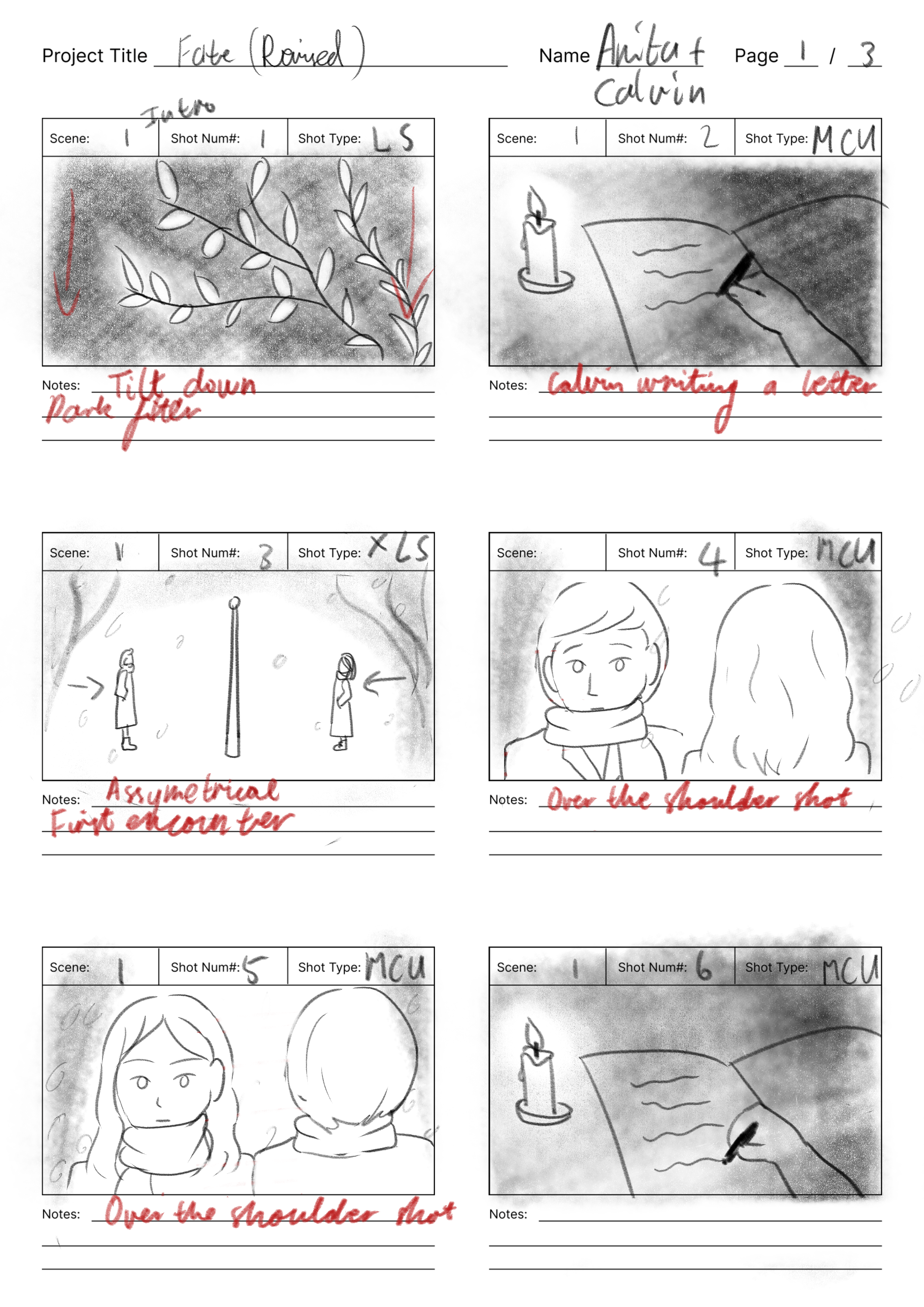
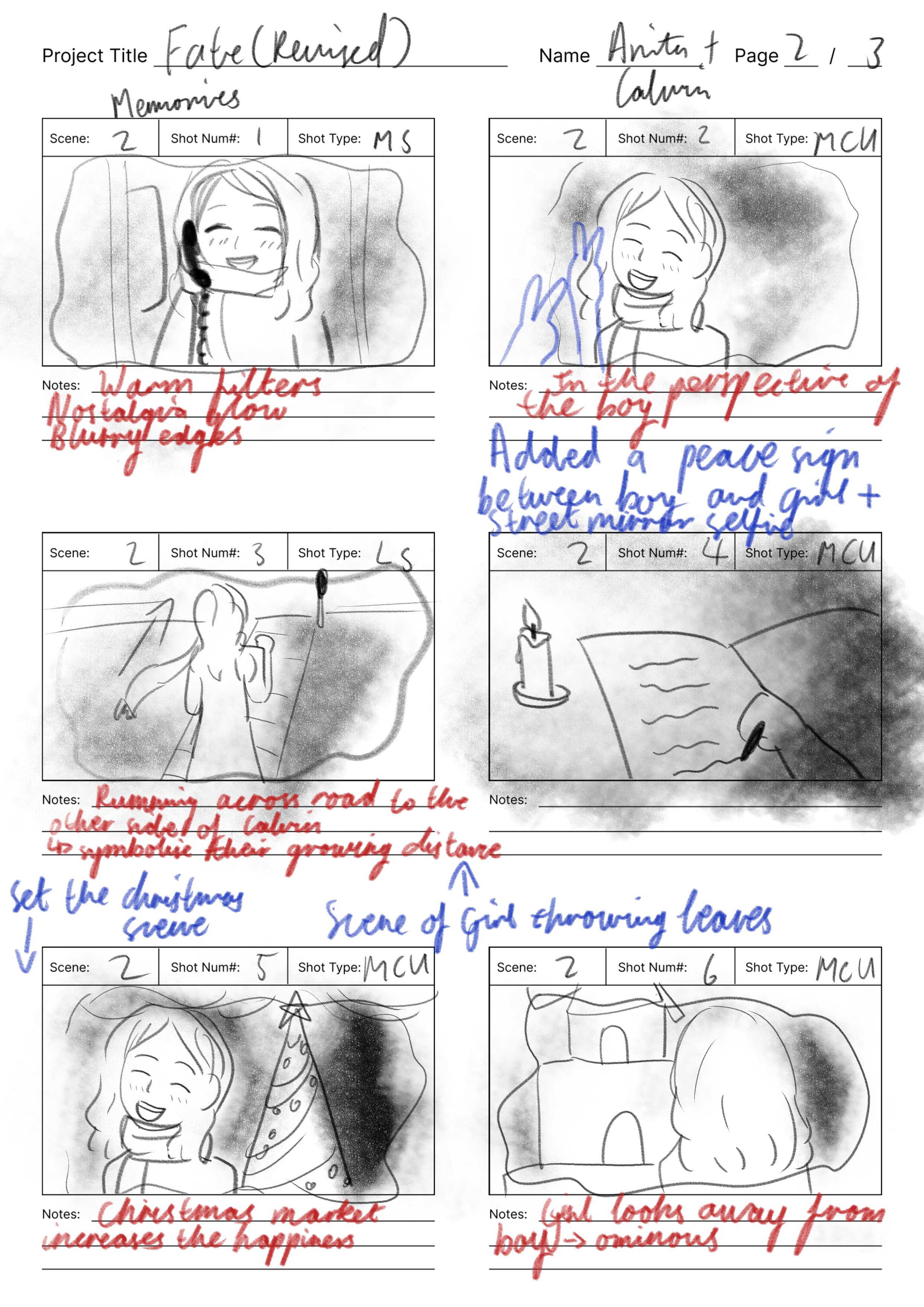
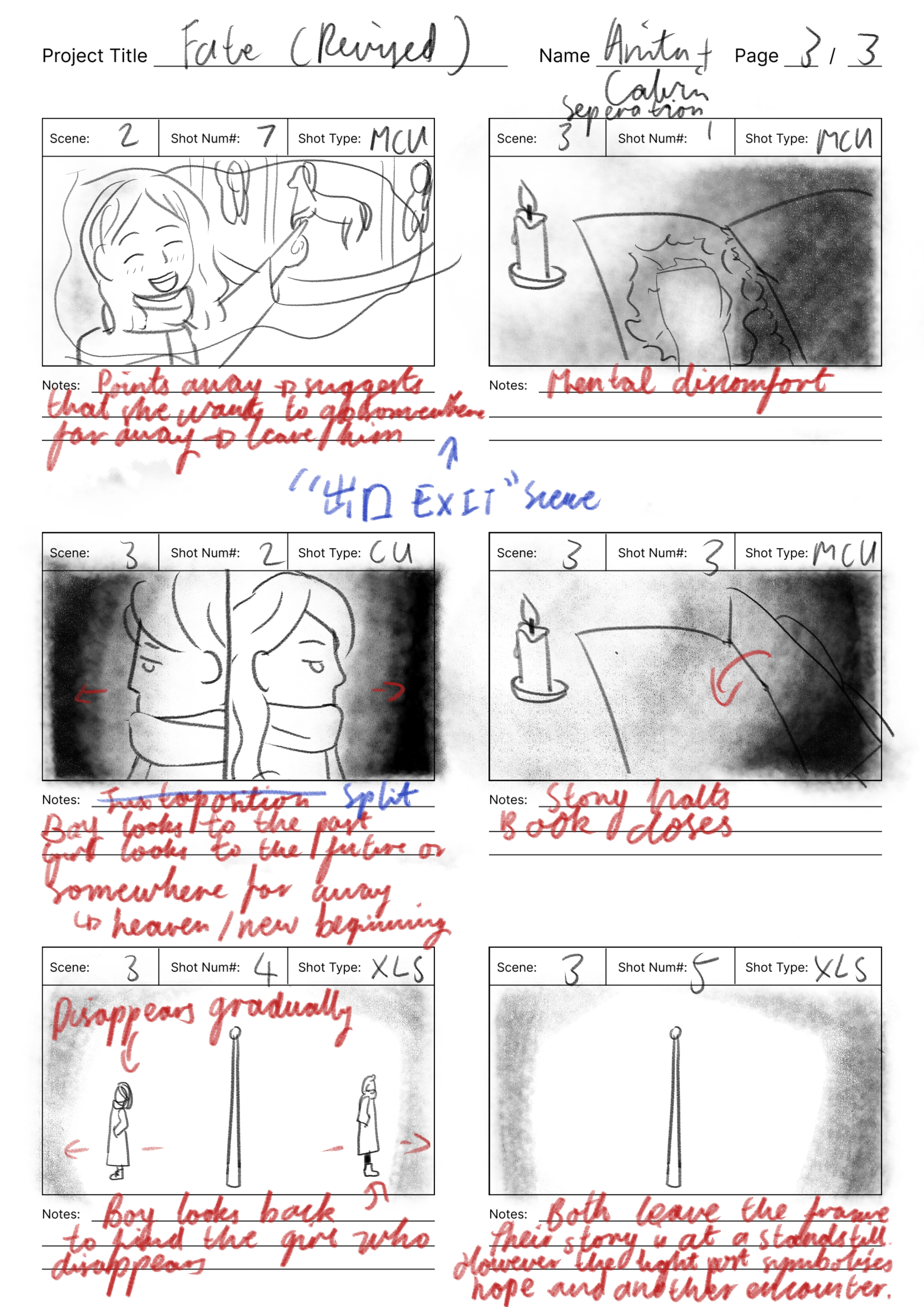
Step 2: Set-up
We borrowed the Canon EOS 6D EF 24-105 f/4L IS USM Camera Kit 011 (32g) for this project. On the day of filming, we set up the camera with a tripod or had one of the team members hold onto it. We also used our phones which were set to 4k and 30 frames per second. We also dressed according to the storyboard—winter clothes.
Step 3: Camera and sound checks
We ensured the proper functioning and quality of the camera and cellphone’s camera and sound by filming a video first. We also checked framing, focus, and lighting to capture the scene effectively.
Step 4: Filming
Choosing the right settings was paramount to the success of our project. We meticulously handpicked locations that bore profound significance to our characters, intensifying the emotional resonance of our film. For instance, we opted for a serene park as the backdrop for the initial meeting of the two lovers. This choice not only mirrored the tender nature of their reconnection but also provided a picturesque setting for their emotional journey.
Additionally, we ventured to a charming Christmas market to capture scenes that portrayed cherished memories from their past. Filming in this festive and nostalgic environment allowed us to infuse our project with an enchanting atmosphere that resonated with the rekindled love and longing theme.
Throughout the shooting process, we engaged in meticulous coordination with our actors, ensuring that their performances harmonized seamlessly with our creative vision. This collaborative effort contributed significantly to the authenticity and emotional depth of our film, ultimately elevating the impact of our storytelling.
Step 5: Editing on Adobe Premiere Pro
Screenshot of project
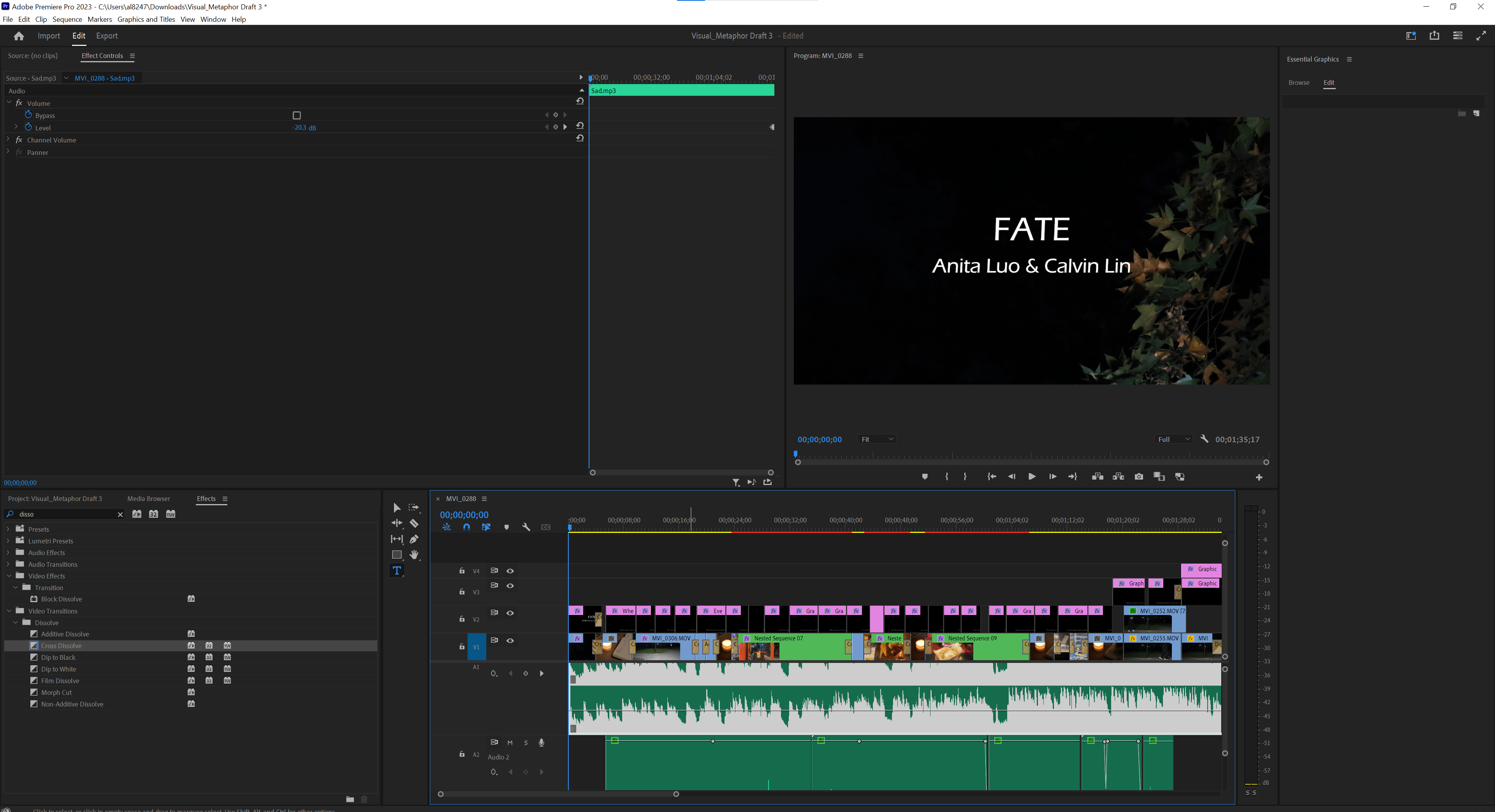
In the editing process, Calvin’s role primarily involved setting up the general framework of our video and overseeing the integration of music, sound effects, and audio creation to heighten the emotional impact of the film. He played a pivotal role in selecting the appropriate music and ensuring it complemented the tone and mood of each scene. Additionally, he handled the initial assembly of the audio elements, establishing the groundwork for the soundscapes that would enhance our storytelling. Following this, he provided the rough draft of the video, which served as the foundation upon which I performed minute editing, including color correction and fine-tuning. This collaborative effort ensured that our final product was a seamless, cohesive, and emotionally resonant narrative that engaged our audience effectively.
Calvin felt a great sense of accomplishment when working on the concluding scene, where the female character gracefully disappears, and the male character slowly turns around. Experimenting with the video’s opacity added an intriguing and captivating element to the process.
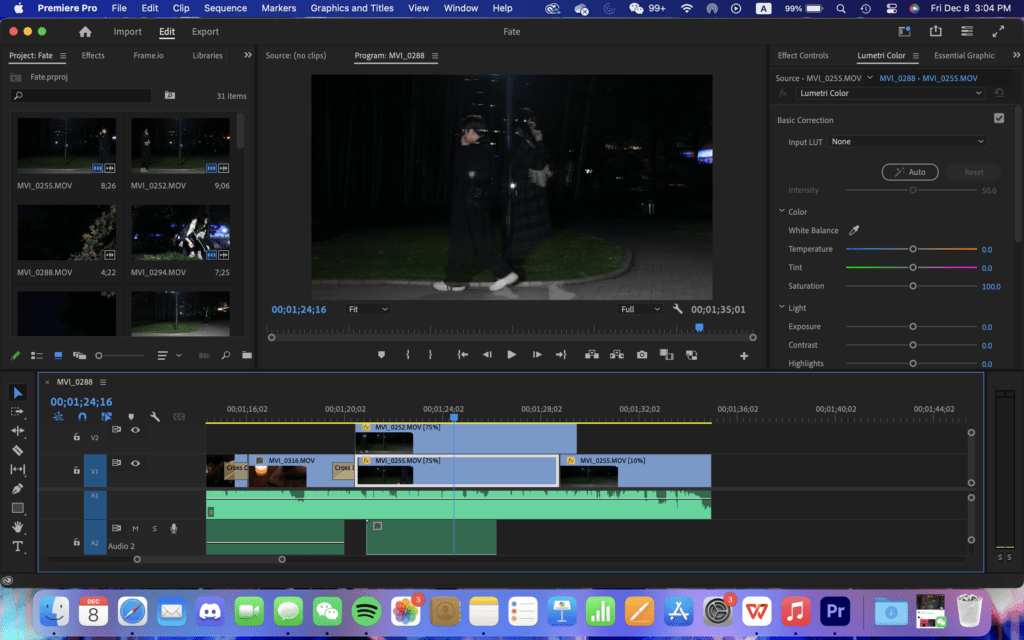
The following were my contributions during the editing phase.
Chrome aberration nest sequence
I first duplicated the scene 3 times. Each scene had the “Color Balance (RGB)” effect and I adjusted each to have only red, green, or blue. I then adjusted each scene’s scale to create a chrome aberration to enhance the nostalgic effect.
Additionally, I did some color corrections in the “Lumetri Color” panel.
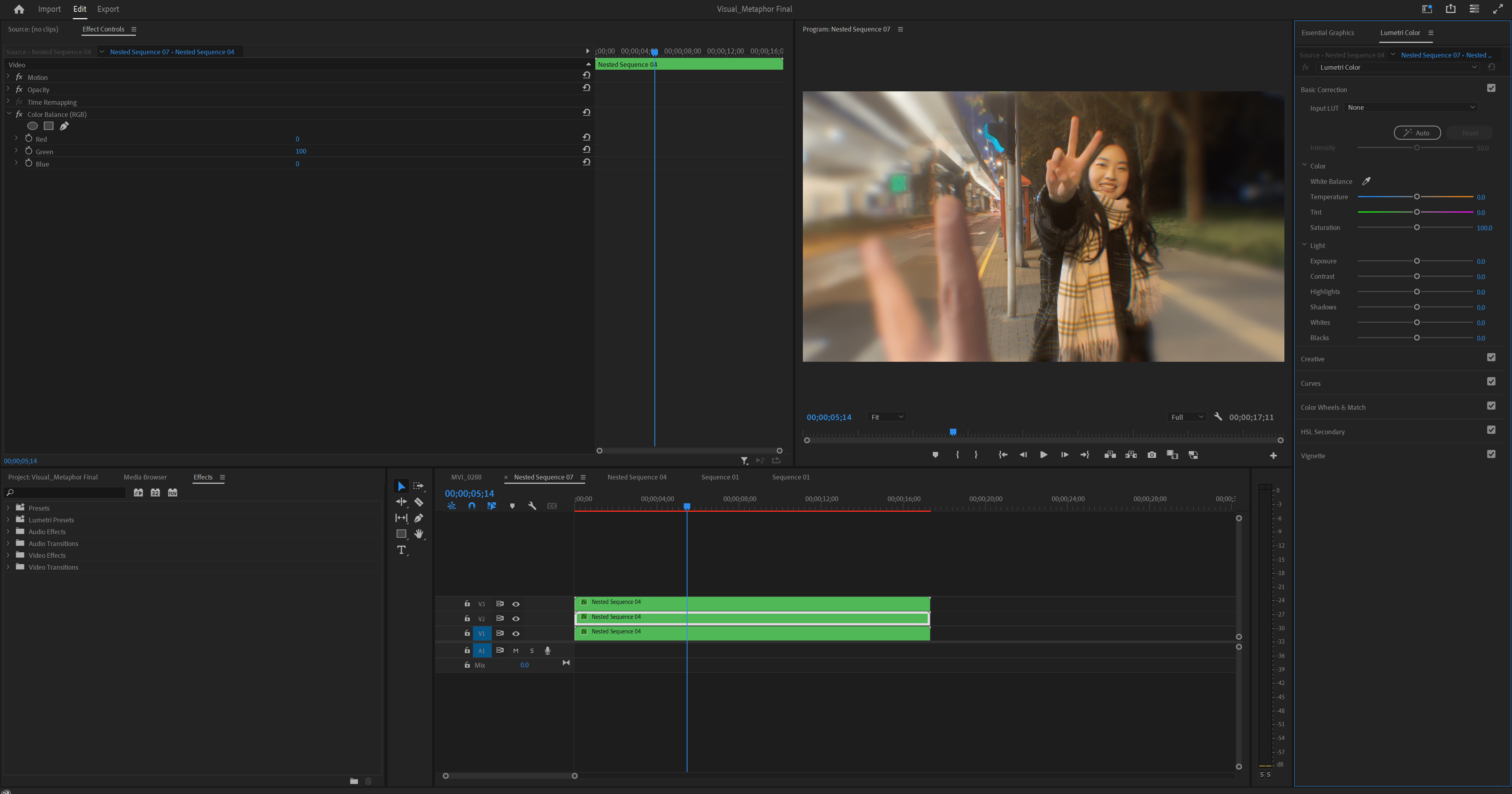
Nostalgic glow
I utilized “Luma Key” and “Gaussian Blur”.
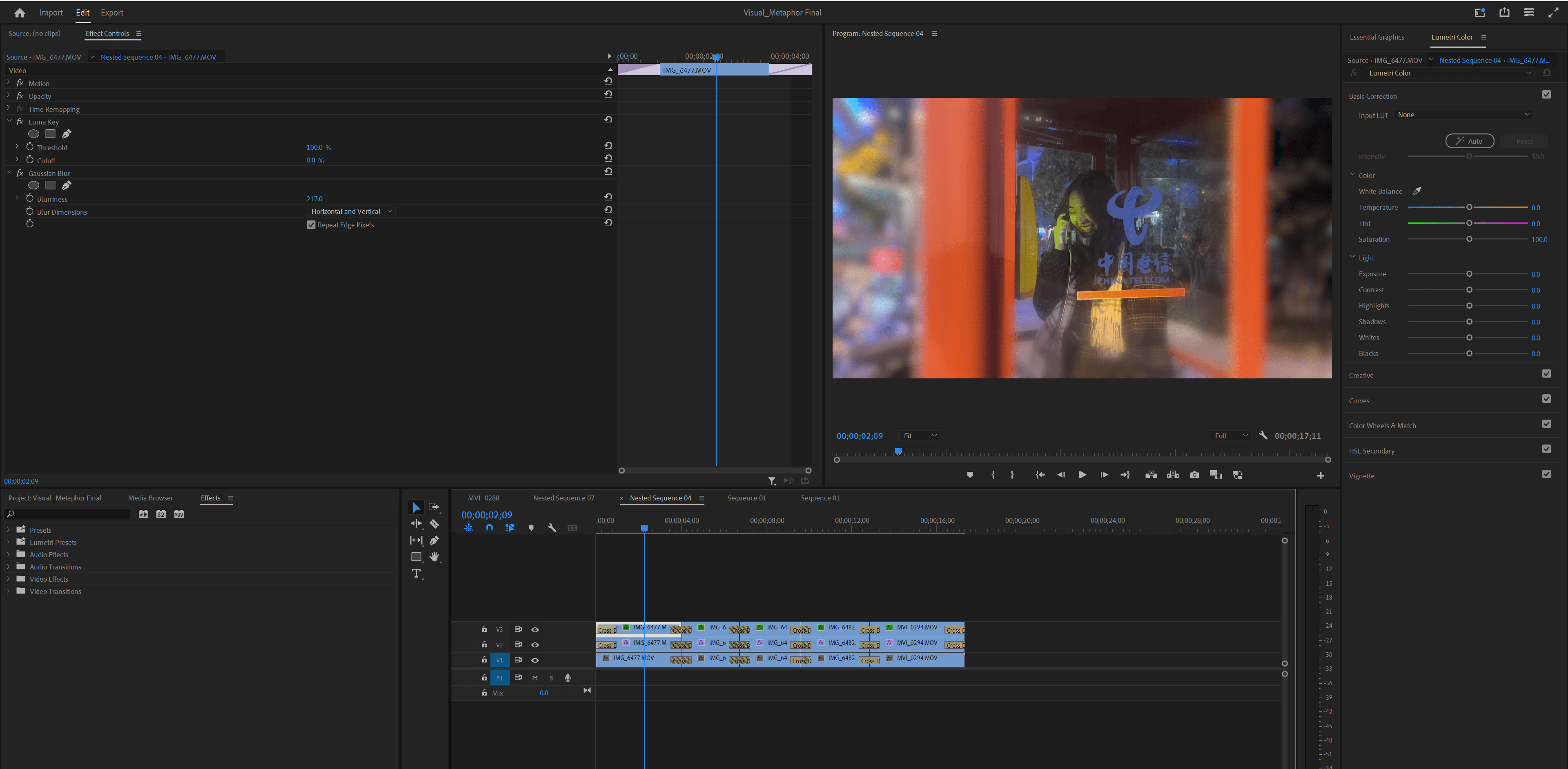
Nostalgic blur
I created the blurry effect by adding a circular mask of “Fast Blur.”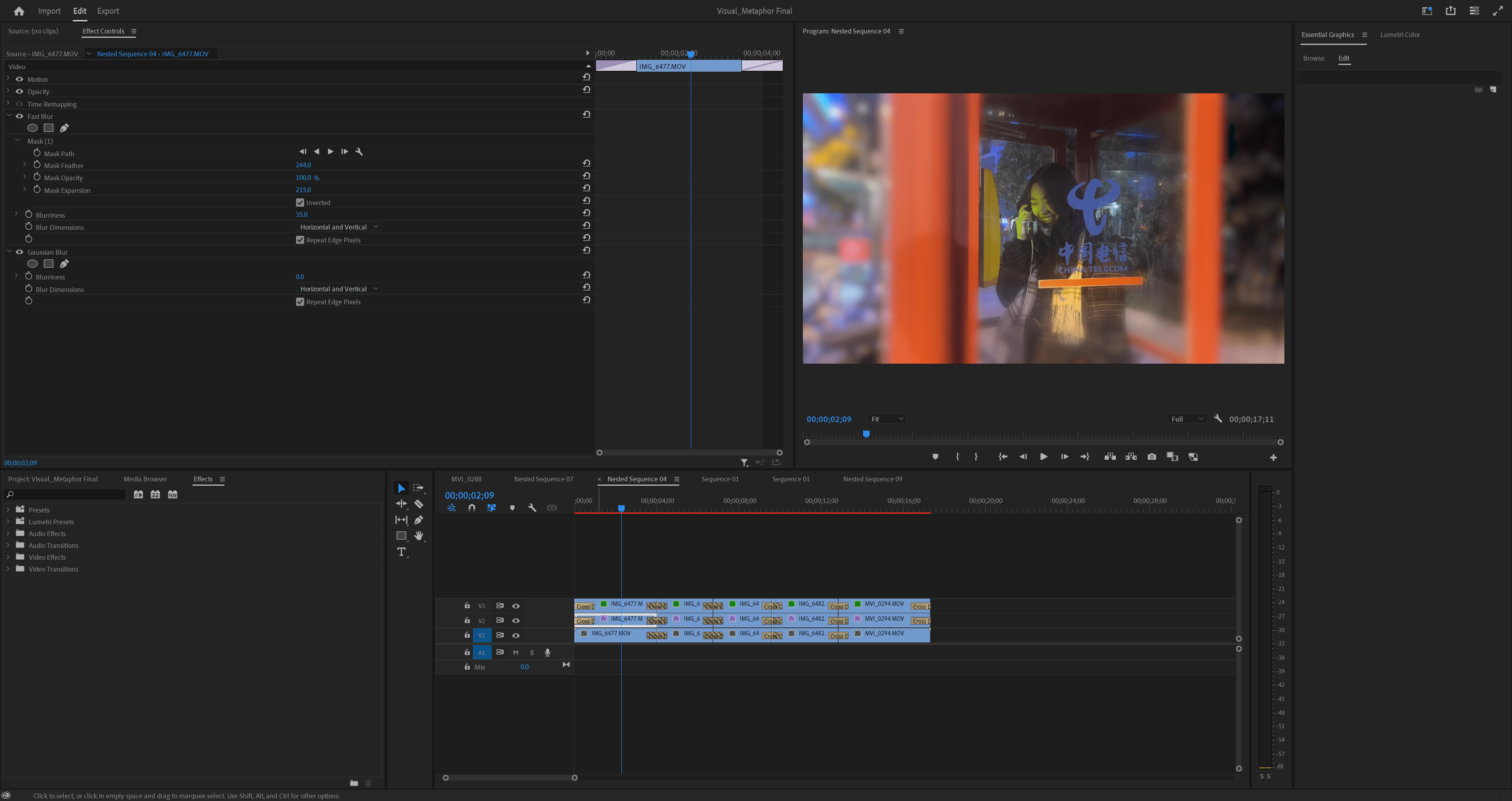
Credit roll
I created two separate text boxes which were placed on each side of the poll. I then enabled the “Roll” feature which helped me complete the final credits scene.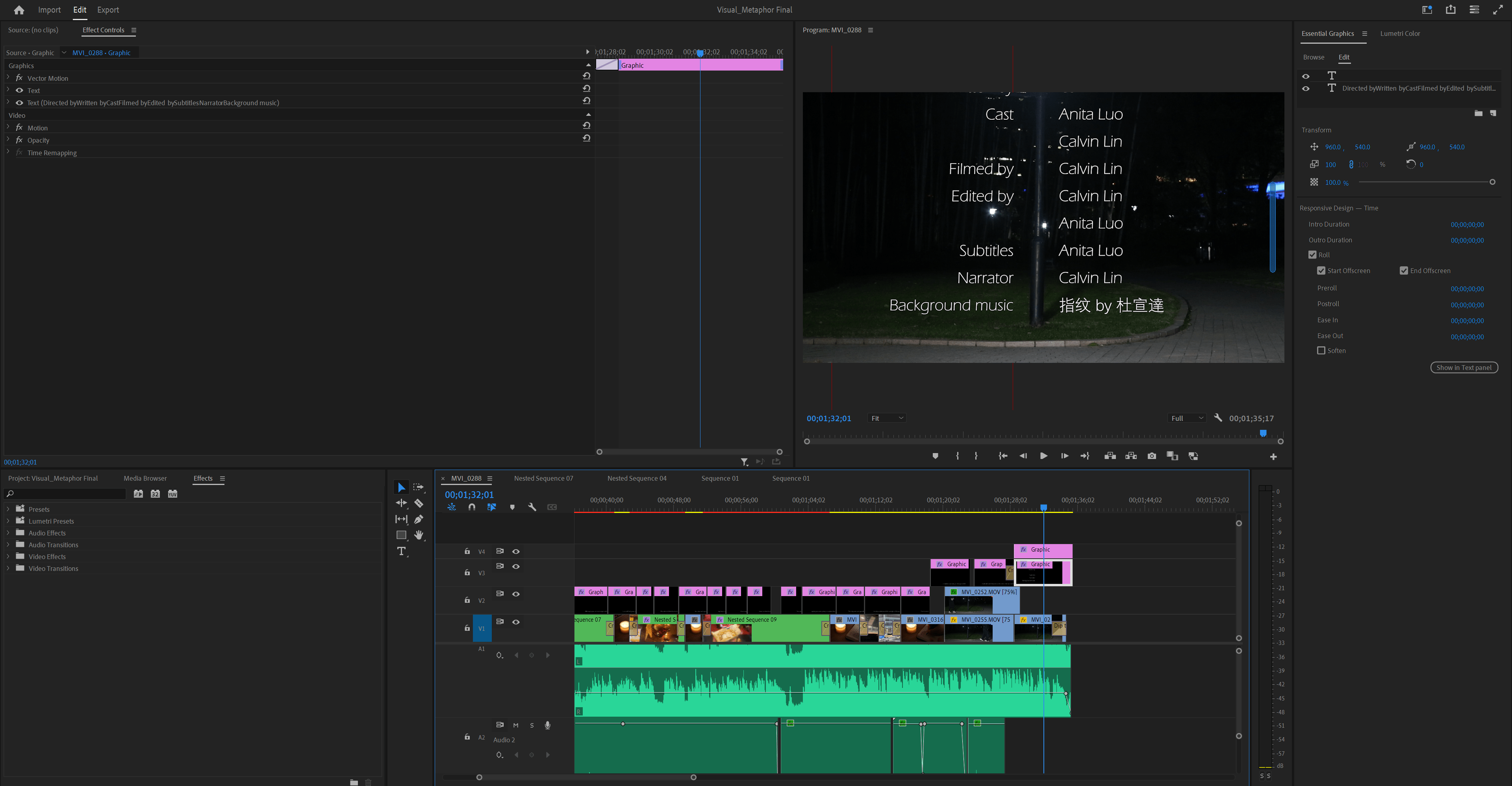
The following shows the copyright status for our use of the background music.
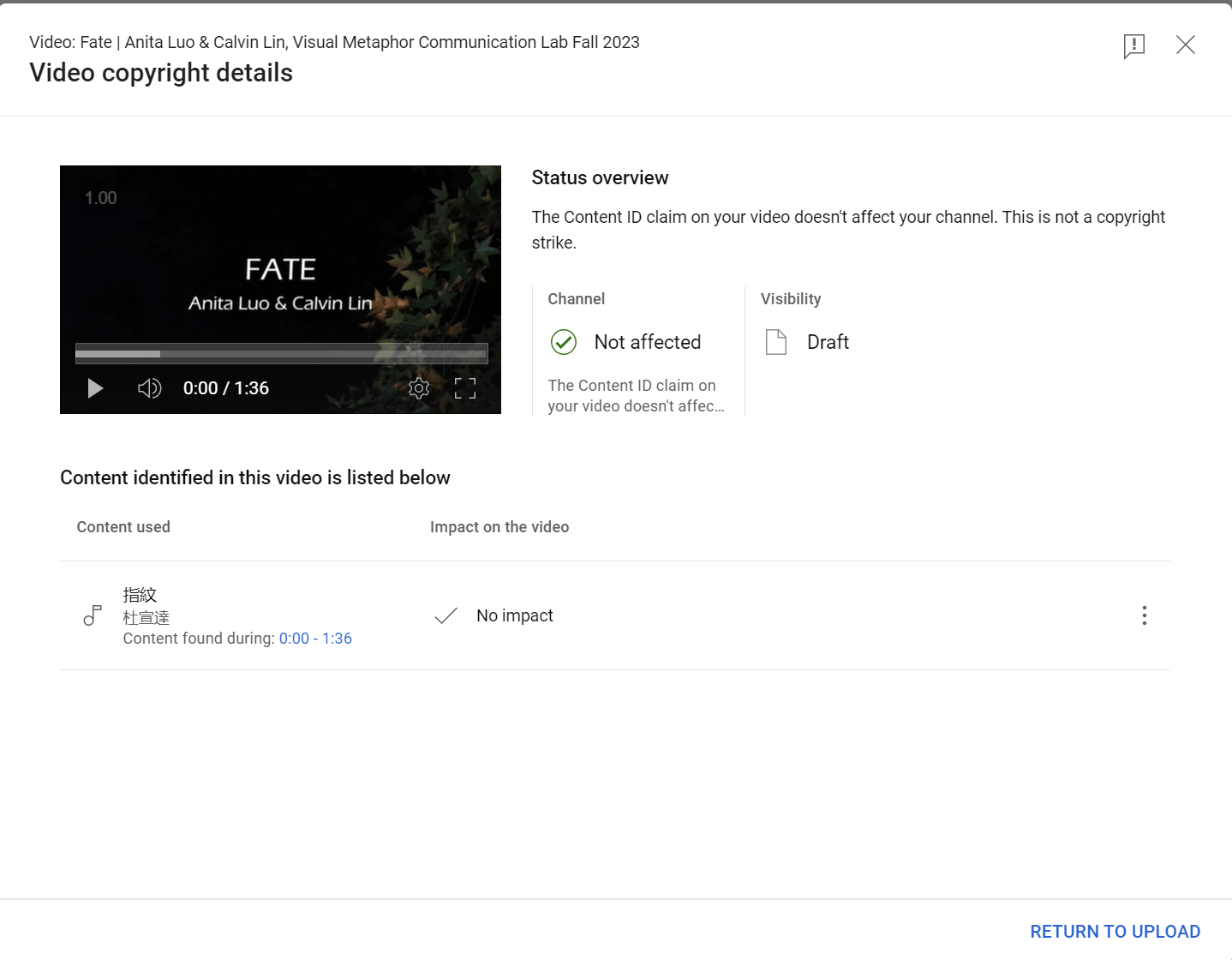
Step 7: Final Adjustments
The following video is an old draft:
When we rewatched our video we found a few places that we could fix. For example, the background music was too soft, and the background music credit was incomplete. Although we had doubts about whether the blur effect was too much or not, we decided to keep it after a consultation with our professor.
Adaptation Mapping
We initially had two ideas which included the idea of a plate metaphorically representing a person. As the person experiences hardships, challenges, and societal pressure throughout the day the plate would overflow and cause the person to have a “crash.” However, while filming these scenes, we did not think that the message was conveyed very well with the scenes we had in hand. Thus, we decided to do our other idea about a love story. Furthermore, we initially wanted to use the heart-shaped streetlights in the love story to show a metaphor for their love which eventually was not used.
Storyboard
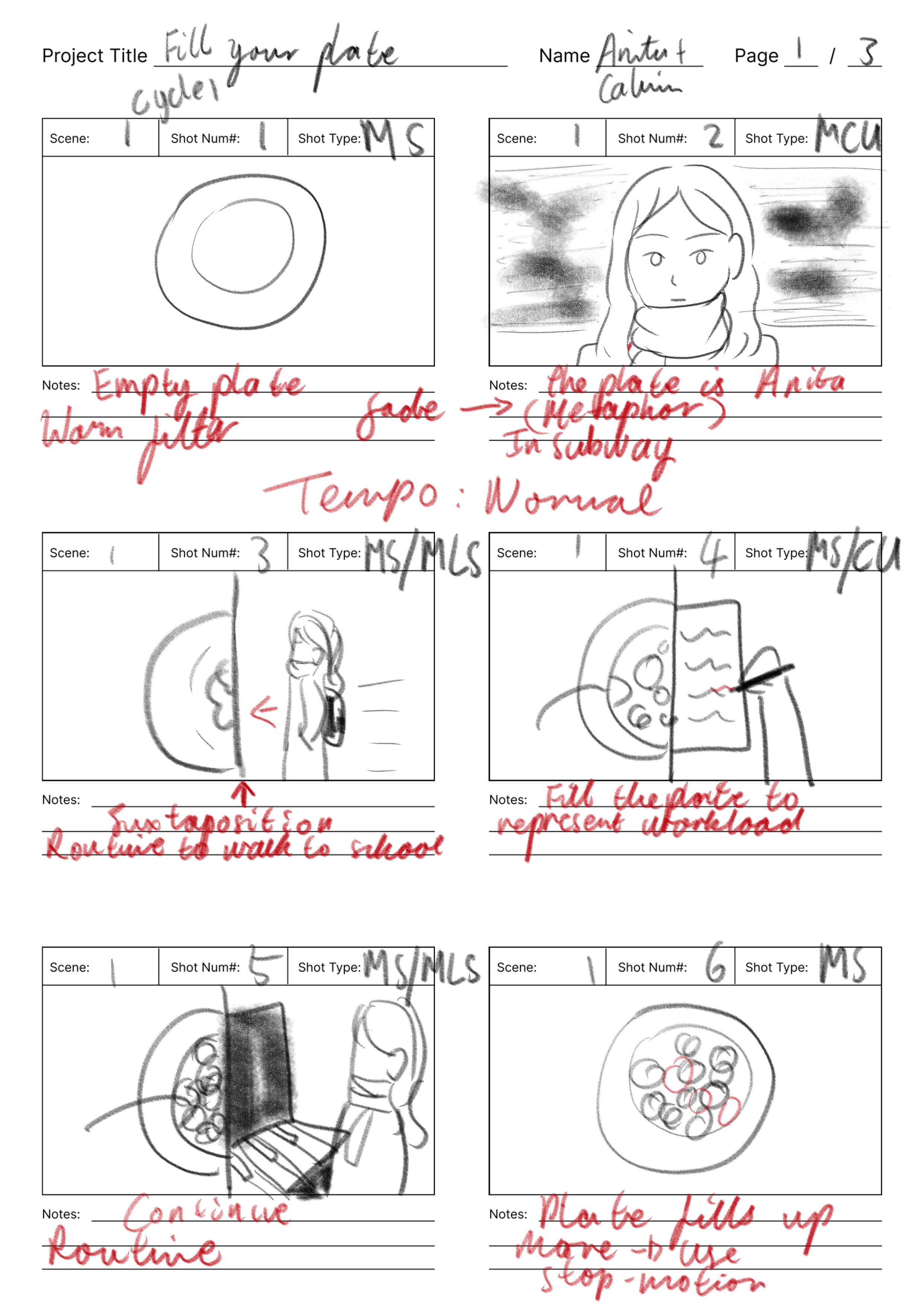
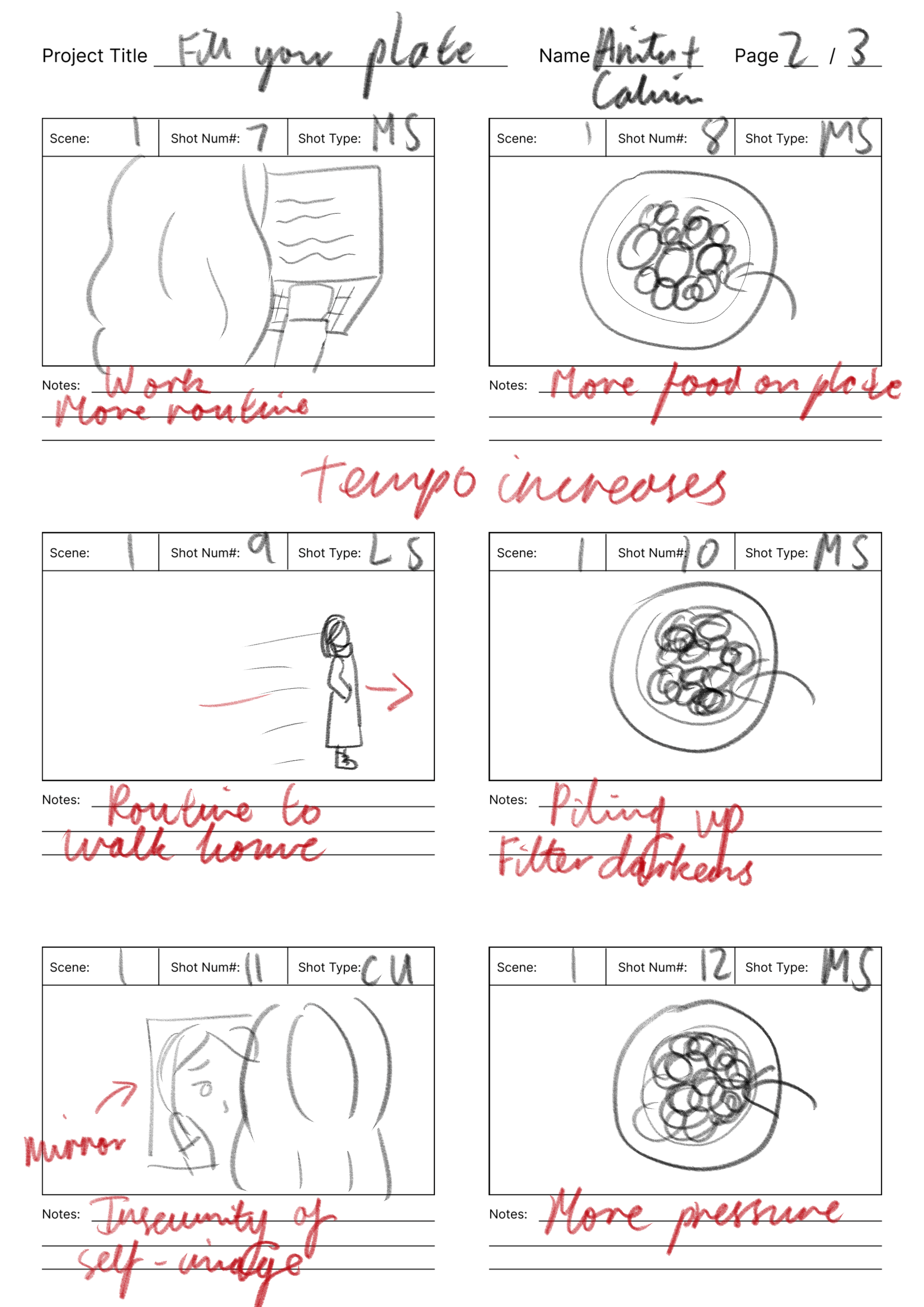
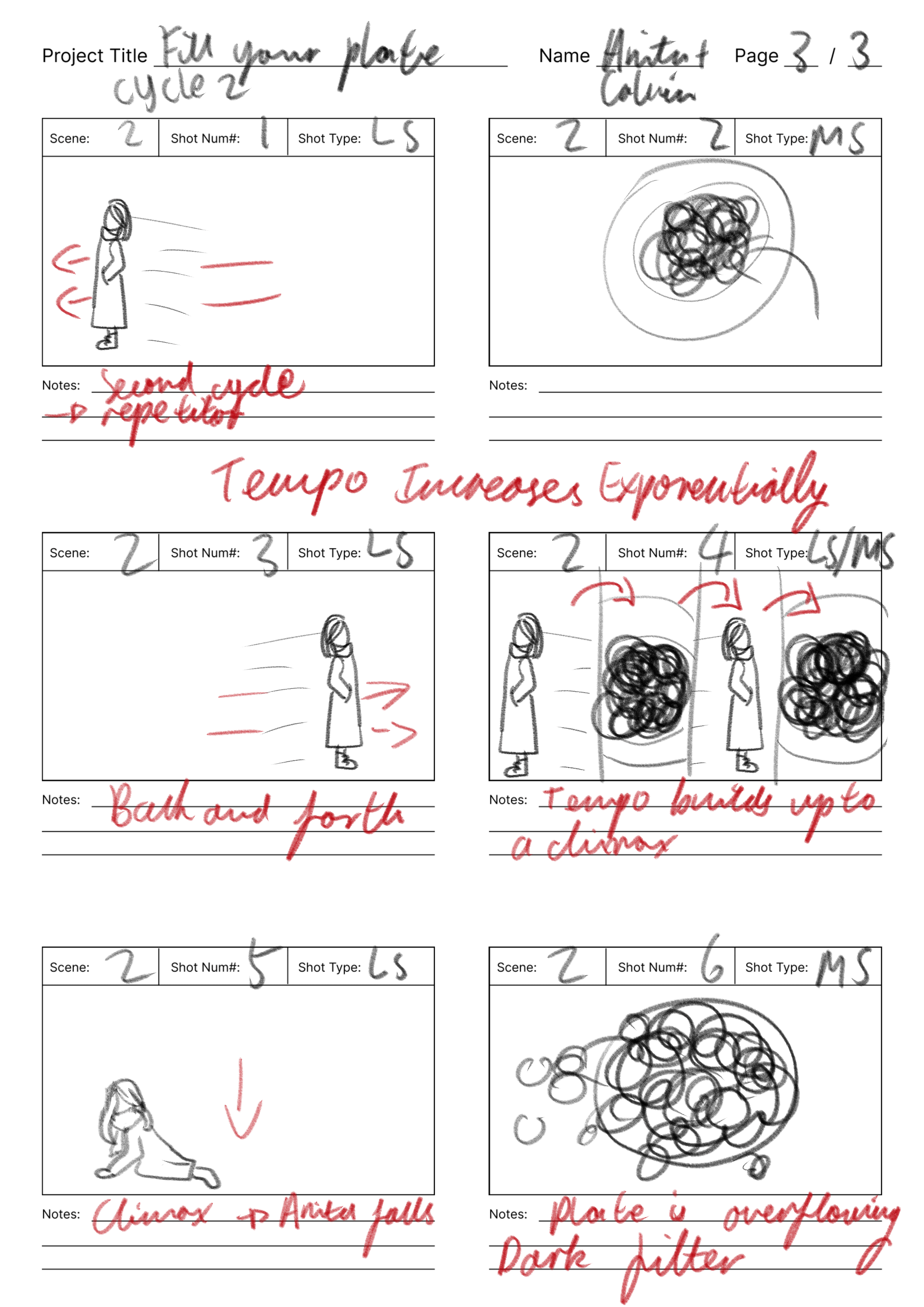
Scenes filmed
Weather
One significant challenge we faced during our project was the unpredictable weather conditions during outdoor shoots. To address this, we established backup shooting days and invested in weatherproof equipment, ensuring that adverse weather wouldn’t disrupt our production schedule or damage our gear.
No cameraman
We encountered difficulty filming certain scenes due to the absence of a dedicated cameraman. To overcome this hurdle, we had to meticulously set up the camera in advance using a tripod, requiring precise planning and coordination. In tandem with these challenges, emotional scenes demanded extensive preparation and support for our actors, necessitating rigorous rehearsals to ensure authentic and heartfelt performances that aligned with our creative vision.
Additional notes by Calvin
Roles & Contributions:
In our collaboration, I handled the scriptwriting, directing, narration, cinematography, and initial editing aspects of the project. My teammate, Anita, contributed to character development, location selection, editing, and cinematography. We both provided feedback on each other’s work throughout the project.
Appreciation:
I would like to express my appreciation for Anita’s dedication and creative input. Her expertise in editing added depth and visual appeal to our project.
Learning from Each Other:
The collaborative process allowed us to learn from each other’s strengths. I gained a deeper understanding of editing and color corrections, while Anita learned more about cinematography and story-telling
Camera Language:
We used various camera angles and shot compositions to convey emotions. Close-ups were used to capture subtle expressions, while wide shots emphasized the characters’ isolation and longing.
Color Correction/Adjustment:
We employed color correction to create a dreamy and nostalgic atmosphere. Warm and muted colors were used to evoke a sense of nostalgia, while subtle shifts in color tone helped differentiate between flashback and present-day scenes.
Tone/Pace of Video:
The tone of our video was contemplative and paced to allow viewers to immerse themselves in the character’s emotions. Slow, deliberate pacing during emotional moments helped convey the depth of their feelings.
Overall, our project “Fate” aimed to create an emotionally resonant and visually compelling narrative. Through collaboration and careful attention to aesthetics, we sought to engage our audience and provoke thoughtful reflection on the themes of love and nostalgia.
Audience Reception
Our classmates praised Calvin’s editing of the female lead vanishing in the last half of the video. It captured the heart-wrenching situation in which the male lead loses his partner. Furthermore, the scene’s emotional respect heightens as the male lead turns around to find no one there while the line states that their story halts at 20 years of age.
The audience was able to interpret the video in the way that we envisioned. There is a duality of meaning in our video: the female lead had either passed away or broke up with him. In this way, we highlight the visual metaphor as we can compare a partner leaving your life after break up as them passing away and no longer existing. Furthermore, it captures the male leads’ hope, which is symbolized by the lamppost, that the couple will be together again in the next life.
Additionally, the motif of the handwriting scene allows the audience to follow along logically as well as offers them the sense of time and space of the narrative.
Rationale
The final project allowed me to embrace how fiction—visual metaphors—can inform the truth and create a compelling piece of work. By exploring the theme of love we also explored the theme of fate and how a concept could be 3-dimensional and multi-faceted. Thus, we can see that everything in our lives, every feeling, certain time, and space can be delved in deeper—nothing in our lives is restricted at its surface level. The way in which we capture a scene is like painting an oil painting—it still contains the wet paint within the solidified edited scenes—which enriches our view of the world and our lives.